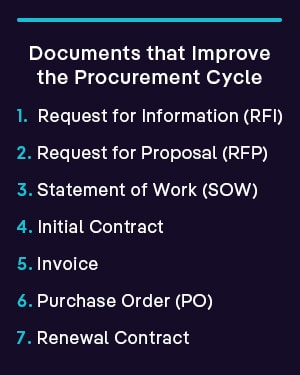What is the Procurement Cycle?
Procurement is essentially finding and purchasing the goods or services necessary to keep a business running successfully. The procurement cycle is all of the individual processes required to find/select a vendor, buy the good/service, and then manage the ongoing vendor relationship and performance.
Steps of the Procurement Cycle
There are several key stages in the procurement cycle that are important to secure the best value for your organization:
1. Identify the Business Challenge or Need 
First and foremost, the procurement process begins when a company identifies a challenge that can be solved by purchasing a product or service. There is a need for something to change, such as investing in new software or new office furniture to replace broken pieces. This step can begin with anyone in the company that recognizes a challenge but is often escalated to the executive team and a procurement team or manager. After due diligence is completed with requirements discovery or an internal business case document, a solution is presented.
2. Obtain Approval to Purchase
Once a solution is suggested, there should be an approval process in place to consider several important factors.
- Is there an existing budget for the goods or service?
- Will the solution fix the problem?
- What is the timeline for delivery?
- Who is responsible for the good or service once it’s purchased?
3. Create and Deliver RFx
Now that your need has been clearly established and approval has been given, it may be time to draft a Request for Proposal (RFP) to compare qualified vendors. While not every contract warrants and RFx, however for more for more ‘comprehensive’ goods / services, a more formal process is typically followed.
An RFP is a standardized business document that defines a project and solicits bids from several contractors to complete. It makes it easier for a company to make a data-based decision, ensure consistency and fairness to each vendor, enable transparency, and reduce organizational risk. Some organizations use a Request for Qualifications (RFQ) or a Request for Quotation (RFQ) as well.
However, before reaching a final decision, it is advisable to leverage a Request for Information (RFI) to share your challenge with vendors and obtain suggestions for potential solutions. By doing so, your business can make more informed decisions about how to proceed. After due diligence is completed with requirements discovery or an internal business case document, a solution is presented.
4. Evaluate and Choose Supplier
This stage is very critical as you are choosing the best vendor based on information received in the RPF, as well as any follow-up documents or conversations. All RPFs should be equally assessed and evaluated on several metrics, including financial stability, delivery timelines costs and fees, corporate stability, reputation, historical success within the industry, and more.
While every company may have different criteria for completing the evaluation, nearly all businesses strive to choose the supplier that will provide the most value at the most reasonable cost, with the least amount of risk.
5. Draft Contract and Negotiate Payment
Creating a contract ensures that the terms of your project are legally binding and are beneficial to all parties involved with the exchange. This step helps establish a positive relationship for future transactions as well. Price is a primary consideration and terms should be thoroughly analyzed, including timelines, itemized fees, contract duration, performance expectations, and language if the contract is breached. It’s worth noting – this isn’t always a linear process. Sometimes a draft contract will go out with the RFP in order to 1. start the negotiation process early (albeit in parallel with multiple parties) and 2. flush out any suppliers upfront who won’t accept our terms.
It’s important to note that the contract negotiation process isn’t always straightforward. In some cases, a draft contract may be included in the RFP to jumpstart negotiations early on. This allows for parallel discussions with multiple parties and can help identify any suppliers who won’t accept the terms upfront.
Once the final contract is approved, a Purchase Order (PO) is created. The contract typically governs the full buyer/supplier relationship, while a purchase order’s focus is the specific purchase. POs typically include the company’s name that is making the purchase, the date, a PO number, the description and quantity of the goods or services required, price and payment details.
6. Execute Implementation or Delivery
After all the work you’ve done in steps 1-5, it is now time to leverage your new goods or service. Depending on what you purchased, this step can be extensive with potential training, implementation, and even onboarding new employees. It is important that special care is taken during this step to reap the most benefit from your investment. Were the goods delivered on time, with the correct quantity and quality? If not, are there procedures in place to rectify the mishap? Ensure clear and transparent communication with the supplier throughout the procurement cycle.
7. Review Vendor’s Performance
In order to maintain collaborative, favorable, long-term relationships with your vendors, it is helpful to perform timely evaluations to assess that your needs are fully met within the terms of the contract. Some questions to consider:
- Does this vendor provide the goods and service to meet my business need?
- Has the need changed in scope?
- Do we still need the product/service in the future?
- Is the price still competitive based on any potential market or internal changes?
- Are there opportunities for improvement?
- What best practices should be repeated?
- Are there ongoing commitments (obligations) in the contract which the vendor needs to fulfill? Are they fulfilling them?
Based on the answers, there are a few options:
- Renew contract: Both parties are satisfied and would like to continue the business relationship and uphold the contract terms
- Renegotiate: Update or change the deliverables or contact language to better suit your needs
- Cancel the contract: Sever ties with the vendor
- Restart the procurement cycle: Seek new vendors and explore different options
Documents & Agreements to Improve the Procurement Cycle
There are a number of different documents that can be used throughout the procurement process to ensure timely success.
Request for Information (RFI): A document that solicits written information about the capabilities of various suppliers in order to compare and make a decision on next steps.
Request for Proposal (RFP): A document that solicits vendors to submit business proposals in order to procure a commodity, service, or asset.
Statement of Work (SOW): A document that is often used in project management, it is a detailed description of a project’s work requirements for a vendor providing services, including product specifications, deliverables, and timelines.
Initial Contract: A legally-binding document agreed upon by both parties that details all of the relevant terms involved with procuring the good or service.
Invoice: A document issued by a seller to a buyer that defines the products, quantities, and agreed-upon prices for products or services. It should also include payment terms.
Purchase Order: A commercial document and the first official offer issued by a buyer to a seller, outlining types, quantities, and pricing for products or services.
Renewal Contract: The extension of an existing contract between two parties, often with the same terms and conditions as the original agreement. Contracts can also be renewed after further negotiation to alter any of the existing conditions.
Improve Your Procurement Lifecycle with ContractPodAi
Procurement, and all of the respective contracts, can seem overwhelming. Fortunately ContractPodAi’s contract lifecycle management (CLM) software makes it easier. Our CLM platform stores all of your contracts in one secure, searchable repository. Automated reminders enable you to stay on top of upcoming renewals or deadlines.
It also provides streamlined workflows to help with the entire CLM process, from contract creation to expiration. Users leverage ContractPodAi to ensure compliance, promote improved collaboration internally and with external vendors, and stay more organized with their procurement processes.
Contact us today to start your CLM journey.










